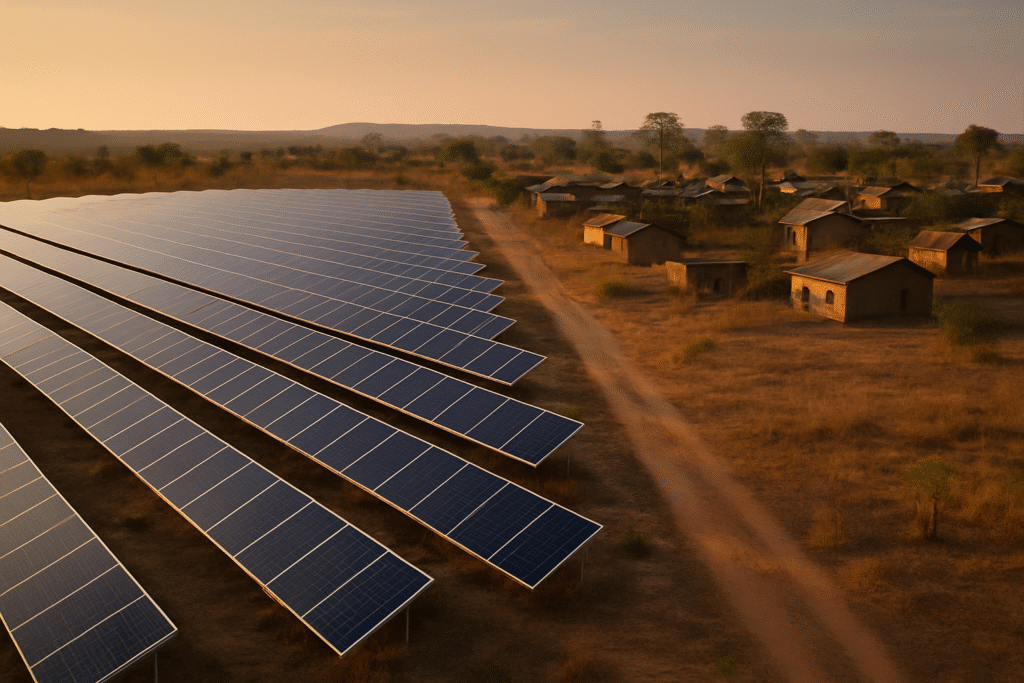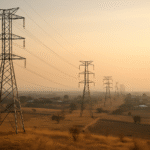|
Getting your Trinity Audio player ready...
|
Africa is gaining clean-energy capacity at a pace unmatched in its modern history. From Morocco’s vast Noor solar complex to Kenya’s wind farms, South Africa’s rooftop boom, and Nigeria’s swelling mini-grid sector, a genuine surge is underway. According to the latest International Energy Agency (IEA) analysis, Africa is set to add more solar capacity in the next decade than it has in the last three combined. The agency projects that solar alone could make up nearly 40 per cent of new electricity capacity additions across the continent.
This is not just a milestone; it is a transformation.
And yet, Africa remains the continent of energy scarcity.
More than 600 million people still live without electricity, and nearly one billion rely on firewood or charcoal to cook. Businesses continue to operate at the mercy of unreliable grids. Households in dozens of countries face daily power cuts. Clinics, farms, and schools struggle not because of a lack of innovation, but because of a lack of power.
Africa is living with a contradiction:
It is becoming a renewable-energy powerhouse while remaining energy-poor.
This is the central paradox that the IEA, the African Development Bank (AfDB), and numerous policy institutions now highlight. Africa’s solar boom is real, but its benefits remain uneven. Supply is rising, but access remains stubbornly stagnant. Capacity is expanding, but consumption is not catching up.
The question for policymakers is not whether Africa’s renewable future is possible; it is why that future remains so far from people’s homes, businesses, and daily lives.
The Promise: Africa’s Golden Renewable Decade
The IEA’s latest Africa Energy Outlook (2025) paints a picture of growing momentum. Solar installations are accelerating, driven by falling technology costs, local entrepreneurship, and rising national targets. Kenya already gets more than 90 per cent of its power from renewables. South Africa, despite its load-shedding crisis, has seen a record jump in rooftop solar installations. Nigeria’s decentralised solar systems now deliver more new capacity annually than its central grid.
The drivers behind the boom are significant:
1. Falling costs of solar technology
Solar module prices have decreased by more than 80 per cent over the last decade, making small-scale and utility-scale installations more affordable.
2. Private-sector dynamism
Distributed energy companies, mini-grid developers, and clean-tech start-ups are reshaping markets from Senegal to Ethiopia. Africa is increasingly a laboratory for innovation in electrification.
3. National clean-energy targets and regional power pools
Countries are committing to larger and better-integrated grids. The Eastern and Southern Africa Power Pools hold potential for cross-border energy exchange, enabling countries with surplus solar or wind to support their neighbours.
4. Global climate finance signals
At COP29 and in the run-up to COP30, new concessional finance pledges have been floated, aimed at expanding renewables in Africa. The EU’s “Scaling Up Renewables in Africa” initiative, set to conclude at the G20 in Johannesburg, has raised expectations for a fresh wave of funding to expand solar and grid capacity.
The momentum is meaningful. Africa today is installing more solar than ever before. But a surge in installations does not guarantee a surge in access.
The Paradox: Why the Solar Boom Has Not Reached the People
Despite the enthusiasm, large structural barriers prevent Africa’s renewable capacity from improving the daily experiences of ordinary people.
1. Grid Bottlenecks The Weak Link in the System
Solar capacity is growing, but grid capacity is not. Transmission lines, substations, and distribution networks are outdated, underfunded, and frequently unable to absorb new power.
In many countries, new solar farms are built but cannot evacuate their electricity because the nearest substation is at capacity. According to the IEA, Africa requires USD 30–40 billion annually in grid investment to support its renewable ambitions, more than double current investment levels. Linking Africa’s renewable boom to household access will require grid modernisation a historic scale.
2. Utilities Struggling Under Financial Stress
Many African utilities face structural deficits. Tariffs often fail to reflect full cost recovery, revenue collection is weak, and reliance on expensive diesel backup systems drains budgets. Investors are hesitant to sign long-term power contracts with off-takers whose balance sheets are fragile.
This creates a vicious cycle:
Weak utilities → limited investment → poor reliability → lower revenues → weaker utilities.
Until utilities are reformed through tariff modernisation, ring-fenced distribution entities, private-sector partnerships, or digitalised billing systems, renewable growth will remain systemically constrained.
3. Slow and Fragmented Permitting
Permitting for renewable projects in Africa can take anywhere from 18 months to more than three years. The process is often fragmented across ministries, agencies, and state-owned entities. This stands in stark contrast to regions like Europe, where accelerated permitting laws are being introduced to fast-track wind and solar.
Africa’s permitting challenge is not merely bureaucratic; it is existential. Delayed approvals translate to higher financing costs, missed investment windows, and projects that never reach construction.
4. The Mini-Grid Opportunity Still Untapped
Mini-grids remain one of Africa’s most promising electrification solutions, especially for rural communities. They are cleaner, faster to deploy, and often more reliable than national grids. Yet the sector receives only a fraction of the investment it needs.
Many investors still view mini-grids as risky. Policymakers often lack frameworks to integrate mini-grids into national plans. And subsidies for diesel generators, a common practice across the continent, distort markets and undermine renewable alternatives.
5. Storage and Balancing Resources Are Underdeveloped
As solar and wind grow, Africa will need batteries, pumped hydro, and other storage solutions to maintain stability. But storage infrastructure remains underdeveloped, partly due to high capital costs and limited regulatory incentives. Without investment in storage, solar-rich countries will struggle to supply power after sunset.
This is where Africa’s critical mineral wealth should matter most. Countries such as the Democratic Republic of the Congo, Zambia, and Namibia hold vast reserves of battery minerals, yet very little processing or manufacturing happens on the continent.
Africa must not only deploy batteries; it must manufacture them.
Why Renewable Growth Does Not Equal Energy Access
The heart of Africa’s energy challenge is not generation. It is equity.
Large-scale solar projects often feed national grids without expanding local access. Households located near solar farms remain unelectrified. Rural communities lack distribution networks. Urban informal settlements face dangerous wiring and inconsistent connections. Even where power is available, households cannot afford it.
The solar boom will remain a headline, not a transformation, if people do not feel its impact.
The African Energy Commission estimates that Africa needs to triple its annual access-related investment to reach universal electrification by 2035, even as solar capacity rises rapidly.
Without aligning renewable growth with energy justice, the transition will reproduce old inequalities under a new banner.
What Must Change: A Blueprint for Turning Capacity Into Access
To convert Africa’s renewable surge into real improvements for people and businesses, the continent must pursue structural reforms along four fronts:
1. A Massive Scale-Up of Grid Investment
Governments, development banks, and private financiers must treat grid expansion with the same urgency as generation. Transmission corridors, urban distribution upgrades, and rural grid extension must be prioritised.
2. Mini-Grid Integration and Subsidy Reform
Mini-grids must be elevated to national planning. Countries such as Nigeria and Ethiopia show that mini-grids can electrify rural areas far faster than central grid expansion if policies support them. Diesel subsidies must be phased out where possible to avoid distorting the market.
3. Accelerated Permitting and Regulatory Harmonisation
Africa needs a fast-track permitting system for renewable projects, with clear timelines, single-window approvals, and transparent processes. The pace of approval must match the urgency of electrification.
4. Local Manufacturing and Storage Markets
Africa must move from being a consumer of renewable technologies to being a producer. Policies should encourage battery assembly plants, inverter manufacturing, and solar component factories. This would reduce costs, strengthen supply chains, and create skilled jobs.
Conclusion: A Solar Boom Must Become an Access Revolution
Africa’s renewable-energy expansion is one of the most hopeful stories of the decade. But hope alone cannot light homes or power factories. The transition must be judged not by capacity installed, but by lives improved.
Solar and wind growth demonstrate what is possible. Now the continent must show what is deliverable.
If grid investment accelerates, utilities are reformed, mini-grids are mainstreamed, and storage becomes a continental priority, Africa’s solar boom can become more than a headline; it can become a revolution of access, justice, and opportunity.
“Africa does not lack light. It lacks the systems that deliver it.”


